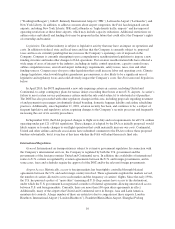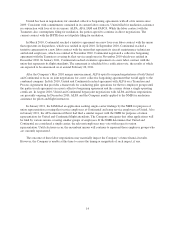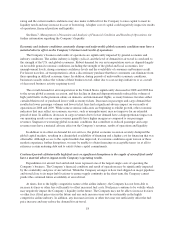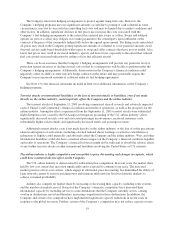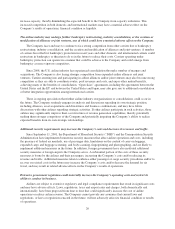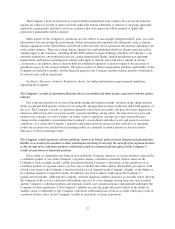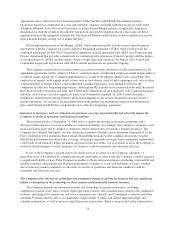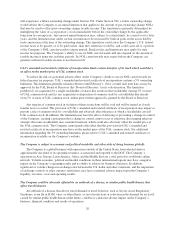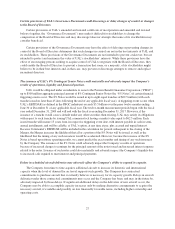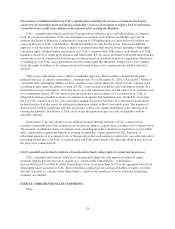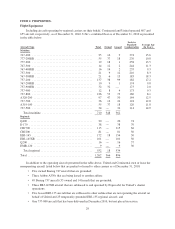United Airlines 2010 Annual Report Download - page 22
Download and view the complete annual report
Please find page 22 of the 2010 United Airlines annual report below. You can navigate through the pages in the report by either clicking on the pages listed below, or by using the keyword search tool below to find specific information within the annual report.increase capacity, thereby diminishing the expected benefit to the Company from capacity reductions. This
increased competition in both domestic and international markets may have a material adverse effect on the
Company’s results of operations, financial condition or liquidity.
The airline industry may undergo further bankruptcy restructuring, industry consolidation, or the creation or
modification of alliances or joint ventures, any of which could have a material adverse effect on the Company.
The Company faces and may to continue to face strong competition from other carriers due to bankruptcy
restructuring, industry consolidation, and the creation and modification of alliances and joint ventures. A number
of carriers have filed for bankruptcy protection in recent years and other domestic and international carriers could
restructure in bankruptcy or threaten to do so in the future to reduce their costs. Carriers operating under
bankruptcy protection can operate in a manner that could be adverse to the Company and could emerge from
bankruptcy as more vigorous competitors.
Since 2008, the U.S. airline industry has experienced consolidation through a number of mergers and
acquisitions. The Company is also facing stronger competition from expanded airline alliances and joint
ventures. Carriers entering into and participating in airline alliances and/or joint ventures may also become strong
competitors as they are able to coordinate routes, pool revenues and costs, and enjoy other mutual benefits,
achieving many of the benefits of consolidation. “Open skies” agreements, including the agreements between the
United States and the EU and between the United States and Japan, may also give rise to additional consolidation
or better integration opportunities among international carriers.
There is ongoing speculation that further airline industry reorganizations or consolidations could occur in
the future. The Company routinely engages in analysis and discussions regarding its own strategic position,
including alliances, asset acquisitions and divestitures and business combinations, and may have future
discussions with other airlines regarding strategic activities. If other airlines participate in such activities, those
airlines may significantly improve their cost structures or revenue generation capabilities, thereby potentially
making them stronger competitors of the Company and potentially impairing the Company’s ability to realize
expected benefits from its own strategic relationships.
Additional security requirements may increase the Company’s costs and decrease its revenues and traffic.
Since September 11, 2001, the Department of Homeland Security (“DHS”) and the Transportation Security
Administration have implemented numerous security measures that affect airline operations and costs, including
the presence of federal air marshals, use of passenger data, limitations on the content of carry-on baggage,
expanded cargo and baggage screening, and body scanning, fingerprinting and photographing, and are likely to
implement additional measures in the future. In addition, foreign governments have also instituted additional
security measures at foreign airports the Company serves. A substantial portion of the costs of these security
measures is borne by the airlines and their passengers, increasing the Company’s costs and/or reducing its
revenue and traffic. Additional measures taken to enhance either passenger or cargo security procedures and/or to
recover associated costs in the future may increase the Company’s costs and/or decrease the demand for air
travel, and may result in related adverse effects on the Company’s results of operations.
Extensive government regulation could materially increase the Company’s operating costs and restrict its
ability to conduct its business.
Airlines are subject to extensive regulatory and legal compliance requirements that result in significant costs
and may have adverse effects. Laws, regulations, taxes and airport rates and charges, both domestically and
internationally, have been proposed from time to time that could significantly increase the cost of airline
operations or reduce airline revenue. The Company cannot provide any assurance that current laws and
regulations, or laws or regulations enacted in the future, will not adversely affect its financial condition or results
of operations.
20


